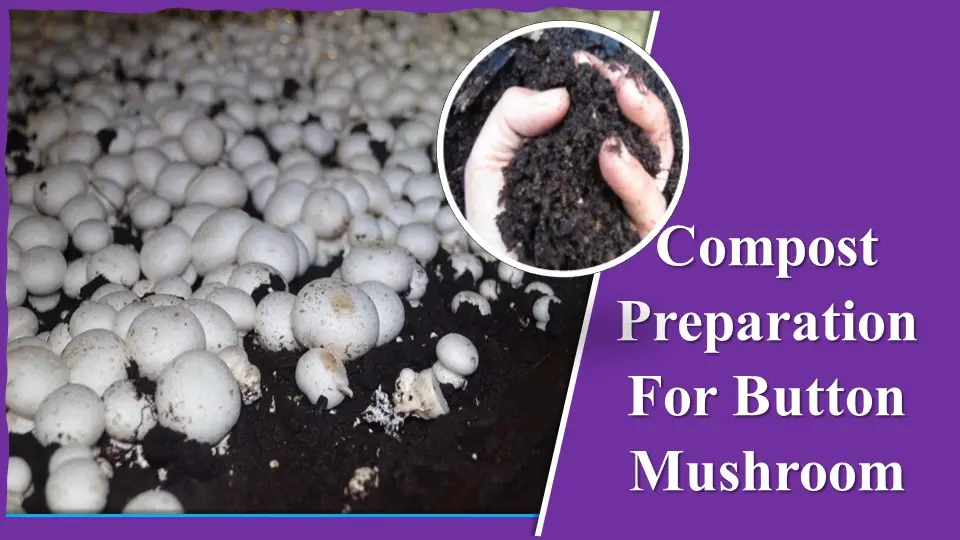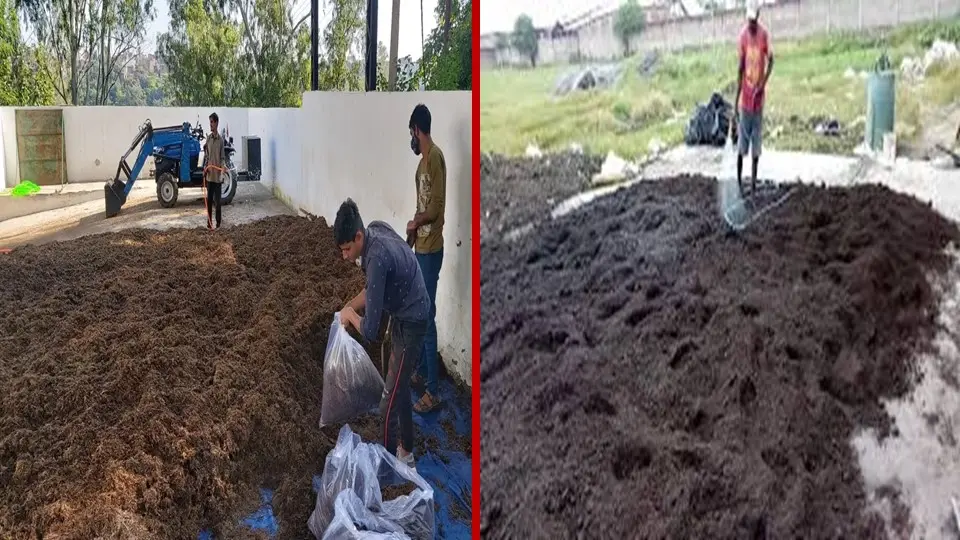Compost preparation for button mushroom

compost preparation for button mushroom is an important steps in mushroom cultivation. Compost is the substrate for mushroom growth obtained after fermentation of agricultural waste (principally cereal straw) by certain beneficial microbes under a particular set of temperature and moisture conditions. The compost provides almost all the essential nutrients, minerals and vitamins required for the growth of mushrooms.
Need of compost preparation
Wheat / paddy straw generally used for compost making is made up of lignin, cellulose and hemi-celluloses (insoluble carbo-hydrates). During composting, the microbes breakdown the insoluble carbon and nitrogen sources present in the straw into a soluble form so that they are readily available to the mushroom. Nitrogen is a major constituent of compost and its supply is traditionally boosted by adding fertilizers and manures which stimulate the activity of microbes during compost making and growth of the mushroom mycelium. Moisture in straw is an essential requirement for the fermentation process and so effective composting revolves around the uniform application of the desired quantity of water.
Types of compost
Compost are of two types, synthetic and natural. Cereal straw and chemical fertilizers are used for making synthetic compost, whereas horse dung and poultry manures are used for making natural compost.
Precautions
- Hygienic conditions should be maintained during the entire operation.
- Wash the equipment with 2% Formalin before use.
- Ingredients should be mixed in exact quantities.
- Follow the compost turning schedule strictly to ensure that the required end product is achieved at the conclusion of composting.
- Excessive wetting of compost should not be done.
- The straw heap should not be over compressed while making stack.
Materials Required For compost preparation
Synthetic compost
- Wheat/paddy straw- 1000 kg
- Wheat/rice bran- 100 kg
- Ammonium sulphate/ Calcium ammonium nitrate- 30 kg
- Urea- 13.5 kg
- Gypsum- 30 kg
Natural compost
Wheat straw (fresh)- 300 kg
Horse dung (freshly collected)- 1000 kg
Poultry manure (2,3-3.0% nitrogen)- 100 kg
Gypsum- 25 kg
Procedure for compost preparation for button mushroom
- Collect fresh wheat/paddy straw from a nearby farm.
- Chop the straw into small pieces (approx. 8-20 cm long) with a chaff cutter and transfer in baskets to the composting site.
- Select a place with pucca floor as a composting site. The site should have a clean floor with a roof/shed and open sides. The floor should have proper slope connected to a giddy pit so that the run-off water could be collected and reused.
- Spread the straw uniformly over the composting yard in a thin layer (9-12 inches deep) and wet it thoroughly by sprinkling water with the help of rubber waterpipe.
- Mix thoroughly the entire quantity of wheat bran, ammonium sulphate/ calcium ammonium nitrate and urea in the wetted straw.
- Make a heap of about 1m wide and 1m high with the help of spade.
- Compress the heap into a loose mound (5 feet high and 5 feet wide with any length) by applying slight pressure with the help of wooden boards (Figure 5).
- Open the entire heap and remake it a number of times according to the following schedule:
Mixing of material and making stack
- 1st turning = 0 day
- 2nd turning = 7th day
- 3rd turning = 10th day.
- 4th turning add gypsum = 13th day
- 5th turning = 16th day
- 6th turning = 19th day
- 7th turning = 22nd day
- 8th turning = 25th day
- Filling = 28th day

- Sprinkle water on the mixture after each turning. The turning is carried out by cutting open the stack with gardening forks, shaking up the manure and then re-stacking in another place on the same site.
- Observe the colour of the compost at each turning. The compost is ready for spawning when the colour becomes dark brown and there is no smell of ammonia. If a smell of ammonia is present, give 1-2 more turnings.
- Take a thermometer and insert in the heap at different spots and record the temperatures during composting. Observe the temperature of the stack daily.
- Test pH of compost with pH paper. It should be between 7.0 – 7.8.
- Observe the moisture of the compost by compressing the compost between palm and fingers. Water should ooze out between the fingers, but it should not trickle down from fingers (palm test). Moisture of the compost should be around 65-70%.
Join Times of Agriculture
Get the latest Agriculture Magazine and regular important updates right on your phone.
👉 Join WhatsApp Group